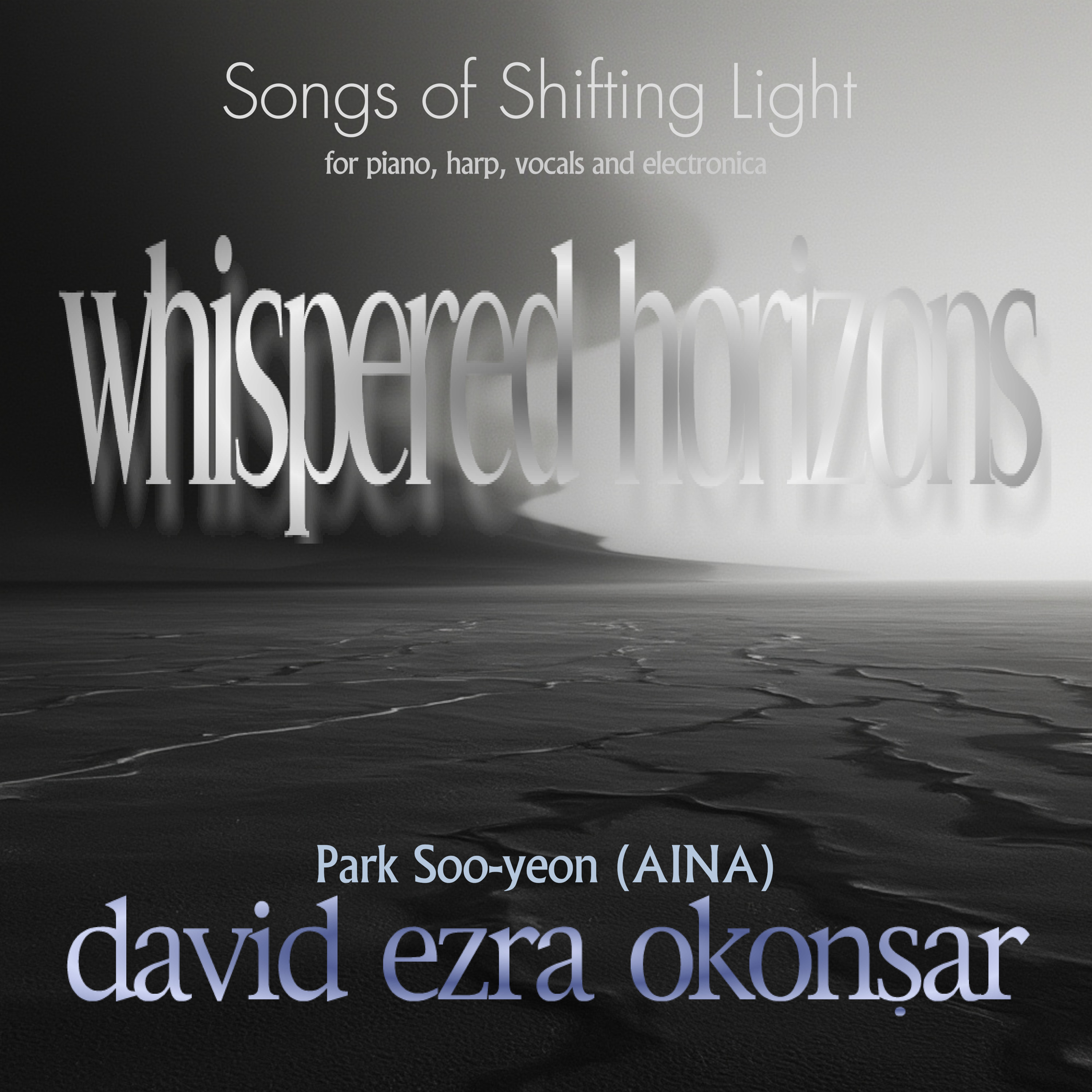
Downloads only. Physical CD not available.
|
Songs of Shifting Light: A Vision of Voice, Void, and Vibration In a digital age teeming with sound and image, Songs of Shifting Light emerges as a singular exploration—one that fuses abstract cinematic beauty with the intimate, corporeal breath of human voice, processed through the crystalline matrix of contemporary technology. At its heart stands a vocalist, poised and serene, delivering lines shaped by symbolist impression and reverent melancholy, amid ever-changing backdrops of animated abstraction and vast natural minimalism. This project, as envisioned and realized by composer and director David Ezra Okonsar, represents a landmark in the integration of virtual performance, modern compositional aesthetics, and AI-assisted multimedia storytelling. It is not an album in the traditional sense, nor merely a sequence of music videos—it is a poetic cycle, a multi-sensory opera of perception, where the boundaries between sound and light dissolve into a seamless continuum of expression. The Music: Atonal Lyricality and Textural Innovation At the foundation of Songs of Shifting Light lies a musical language that defies conventional categorization. It is atonal, yes, but not in the sense of harsh dissonance or chaotic fragmentation. Instead, Okonsar crafts a melodious atonality, wherein dislocated tonal centers open vast emotional and atmospheric space. Each phrase floats untethered, like a beam of light refracted across glass. The core instrumentation is emblematic of this duality between the ancient and the futuristic. The acoustic piano—sometimes raw and percussive, sometimes fragile as breath—serves as both anchor and mirror. The electronically processed harp threads through the work like a spectral narrator, shimmering and dissolving, recalling echoes of Debussy and Boulez re-imagined through digital prisms. Augmenting these is a restrained but deeply expressive use of synthesizers: not as dominant leads, but as subtle forces that expand and bend sonic reality, enveloping the listener in an amorphous dreamscape. Tempo is fluid throughout the pieces—elastic and human. Rhythmic structures dissolve into momentary gestures, always subservient to the flow of lyric and image. This is music sculpted not in meter, but in breath and silence. The Voice and the Words: A Singer in Reverie The vocal performance, rendered through an AI-synthesized and lip-synced singer whose appearance recurs throughout the series, is no less central to the project’s emotional architecture. Her voice is luminous, precise, and nuanced, drawing the listener into a private realm of poetic meditation. Lyrics are formatted in short, highly phrased verses. This structure—developed to accommodate and enhance AI singing tools—also allows for a heightened lyrical experience, akin to haiku or epigram. Each line stands as a poetic gesture: isolated, suggestive, and complete in itself. Breath marks are intrinsic. Commas, pauses, and soft exclamations create space for resonance, reflection, and alignment with the audiovisual pacing. Though the texts are in English, their spirit is unmistakably symbolist and continental. Traces of Mallarmé, Claudel, and even the inward murmur of Tagore thread through the lines. They speak of twilight and horizon, of stillness and emergence, of memory as mist. They do not narrate but suggest, not explain but evoke. The Visual Language: Void, Threshold, and Transformation The visual design of the videos is grounded in abstraction and minimalism—desolate plains, shifting skies, and fluid geometries that breathe and mutate with the music. These environments function as metaphysical spaces: visual metaphors for psychological terrain, inner stillness, and the poetic void. Each video animates this background differently—sometimes subtly shifting gradients of light, sometimes distorting the horizon with pulsating darkness, sometimes adding layers of symbolic abstraction such as lines, particles, or slowly encroaching shapes. These transformations never overwhelm the singer but rather frame her, intensifying the emotional climate of the music. The animated singer herself remains mostly static in posture but dynamic in expression. Lip movements are rendered with precision. Her facial expressions shift subtly, capturing the inner world of the lyric—reflective, mournful, exultant. Hands articulate the line, sculpting space with each word sung. There is no crowd, no scenery, no distraction. She exists in a void, sovereign and luminous. The minimalism of the staging amplifies the immersive quality of the experience. The audience is drawn into a darkened theater of sensation, where time slows, and consciousness floats in suspension between utterance and echo. Technology and Artifice as Intimacy Despite its technologically mediated construction—from AI-generated vocals to fully animated visuals—Songs of Shifting Light never feels synthetic or cold. On the contrary, the use of digital tools enhances intimacy by removing theatrical excess and focusing on essence. The singer's gaze, the trembling piano, the flicker of a background form—these moments carry profound weight, precisely because they are unburdened by realism or spectacle. This is the paradox at the core of the project: by embracing artificiality, it achieves sincerity. By animating the inanimate, it reaches a new kind of presence—one not limited by the stage or body, but still deeply grounded in human emotion and artistic truth. Conclusion: An Offering of Stillness in an Age of Noise In Songs of Shifting Light, David Ezra Okonsar presents a cycle of works that beckon the listener into a realm of abstract clarity and emotional suspension. It is a music of shadows and light, of windswept thresholds and whispered departures. Through its singular fusion of atonal melody, poetic phrasing, and visually minimal yet symbolically rich animation, the project proposes a new mode of musical experiencing—one not bound by narrative or genre, but open, porous, and contemplative. For those who listen not with the ears alone but with the inner eye, this series becomes a mirror, a sanctuary, and a question. What lies at the edge of light? What song lingers when words are gone? Songs of Shifting Light offers no answers. It offers only the silence between verses—and the radiance within.
-------------------------------------------------- FR Songs of Shifting Light : Une Vision de la Voix, du Vide et de la Vibration À une époque saturée de sons et d’images, Songs of Shifting Light se présente comme une exploration singulière — une fusion entre la beauté cinématographique abstraite et le souffle intime, incarné, d’une voix humaine filtrée par la matrice cristalline de la technologie contemporaine. Au cœur de l’œuvre se tient une chanteuse, sereine et posée, qui livre des lignes poétiques empreintes d’impression symboliste et de mélancolie sacrée, sur des fonds animés d’abstractions changeantes et de paysages naturels vastes et minimalistes. Imaginé et réalisé par le compositeur et metteur en scène David Ezra Okonsar, ce projet marque une étape majeure dans l’intégration de la performance virtuelle, de l’esthétique musicale contemporaine et de la narration multimédia assistée par l’intelligence artificielle. Ce n’est pas un album au sens traditionnel, ni simplement une série de vidéoclips musicaux : c’est un cycle poétique, un opéra multisensoriel de la perception, où les frontières entre le son et la lumière se dissolvent en un continuum d’expression fluide. La Musique : Atonalité Lyrique et Innovation Texturale À la base de Songs of Shifting Light réside un langage musical qui échappe aux classifications habituelles. Il est atonal, certes, mais non pas dans le sens de la dissonance rugueuse ou du chaos fragmentaire. Okonsar façonne au contraire une atonalité mélodieuse, où les centres tonals flottants ouvrent un espace émotionnel et atmosphérique immense. Chaque phrase musicale semble flotter, comme un rayon de lumière réfracté à travers du verre. L’instrumentation principale incarne cette dualité entre ancien et futuriste. Le piano acoustique — tantôt brut et percussif, tantôt fragile comme un souffle — joue à la fois le rôle d’ancrage et de miroir. La harpe, traitée électroniquement, se déploie comme une narratrice spectrale, miroitante et évanescente, évoquant Debussy et Boulez réimaginés à travers des prismes numériques. À cela s’ajoutent des synthétiseurs discrets mais expressifs, non pas en tant que voix principales, mais comme forces subtiles qui étendent et déforment la réalité sonore, enveloppant l’auditeur dans une brume onirique. Le tempo est fluide tout au long de l’œuvre — élastique, organique. Les structures rythmiques se dissolvent en gestes éphémères, toujours au service du flux lyrique et visuel. C’est une musique sculptée non pas en mesures, mais en souffles et en silences. La Voix et les Mots : Une Cantatrice en Révérence La performance vocale, rendue par une chanteuse animée et synthétisée par l’IA, est au cœur de l’architecture émotionnelle du projet. Sa voix est lumineuse, précise, nuancée — elle invite l’auditeur dans un espace intime de méditation poétique. Les textes sont structurés en vers courts et fortement phrasés. Ce format — développé pour optimiser le chant généré par IA — offre également une intensité lyrique particulière, proche du haïku ou de l’épigramme. Chaque ligne est un geste poétique : isolée, suggestive, complète en soi. Les virgules, les pauses, les ponctuations discrètes rythment la respiration, la réflexion, l’accord avec la temporalité visuelle et sonore. Bien qu’écrits en anglais, les textes portent une âme incontestablement symboliste et européenne. Des résonances de Mallarmé, Claudel, voire du murmure intérieur de Tagore traversent les lignes. Ils parlent de crépuscule et d’horizon, de silence et d’émergence, de mémoire comme brume. Ils ne racontent pas, ils suggèrent ; ils n’expliquent pas, ils évoquent. Le Langage Visuel : Vide, Seuil et Métamorphose L’univers visuel des vidéos est ancré dans l’abstraction et le minimalisme — plaines désertiques, ciels mouvants, géométries fluides qui respirent et se métamorphosent au rythme de la musique. Ces environnements deviennent des espaces métaphysiques : métaphores visuelles des états psychiques, du silence intérieur et du vide poétique. Chaque vidéo anime ces arrière-plans de manière singulière — en modulant subtilement les lumières, en tordant l’horizon avec des pulsations d’ombre, ou en ajoutant des formes abstraites, lignes, particules ou figures flottantes. Ces transformations n’envahissent jamais la chanteuse, mais la mettent en valeur, amplifiant le climat émotionnel. La chanteuse animée reste généralement statique dans sa posture, mais expressive dans ses gestes et mimiques. Les mouvements de lèvres sont synchronisés avec précision. Son visage traduit les nuances du texte — méditatif, douloureux, lumineux. Ses mains sculptent l’espace. Il n’y a ni décor, ni foule, ni distraction. Elle est seule, souveraine, dans le vide. Ce minimalisme visuel renforce l’immersion. Le spectateur est plongé dans un théâtre obscur de sensations, où le temps se dilate, et où la conscience flotte entre le mot prononcé et son écho. Technologie et Artifice comme Intimité Malgré sa construction entièrement numérique — voix générée, images animées — Songs of Shifting Light ne donne jamais une impression de froideur ou d’artifice. Au contraire, la technologie y sert l’intimité, en épurant l’expérience pour ne conserver que l’essentiel. Le regard de la chanteuse, une note suspendue au piano, une vibration lumineuse à l’arrière-plan : tout cela pèse de sens. C’est là le paradoxe fondateur du projet : en assumant pleinement l’artificialité, il atteint une forme de sincérité. En animant l’inanimé, il crée une présence nouvelle — non limitée par le corps, mais profondément enracinée dans l’émotion et la vérité artistique. Conclusion : Une Offrande de Silence dans un Monde de Bruit Dans Songs of Shifting Light, David Ezra Okonsar propose un cycle d’œuvres qui appellent à la suspension, à la contemplation, à la clarté abstraite. C’est une musique d’ombres et de lumière, de seuils balayés par le vent et de départs murmurés. Par sa fusion singulière entre atonalité lyrique, phrasé poétique et animation visuelle épurée mais évocatrice, le projet inaugure une manière nouvelle de vivre la musique — dégagée de tout récit, ouverte, poreuse, méditative. Pour ceux qui écoutent non seulement avec l’oreille, mais avec l’œil intérieur, cette série devient miroir, refuge, question. Que trouve-t-on au bord de la lumière ? Quelle chanson reste lorsque les mots s’effacent ? Songs of Shifting Light n’apporte pas de réponse. Il offre seulement le silence entre les vers — et la radiance en dedans. --------------------------------------------------TR Songs of Shifting Light: Sesin, Boşluğun ve Titreşimin Bir Vizyonu Ses ve görüntüyle doymuş bir dijital çağda, Songs of Shifting Light eşsiz bir keşif olarak öne çıkıyor — soyut sinematik güzelliği, insan sesinin içten ve bedensel soluğuyla birleştiren, bu sesi çağdaş teknolojinin kristalimsi yapısında dönüştüren bir birleşim. Merkezinde ise, sembolist izlenimlerle ve kutsal bir melankoliyle işlenmiş dizeleri söyleyen, dingin ve duru bir vokalist yer alıyor; değişken soyut animasyonların ve geniş, sade doğa görüntülerinin arka planında. Besteci ve yönetmen David Ezra Okonsar’ın tasarlayıp hayata geçirdiği bu proje, sanal performansın, çağdaş bestecilik estetiğinin ve yapay zekâ destekli çoklu ortam anlatımının bütünleştiği bir dönüm noktasıdır. Bu çalışma ne geleneksel anlamda bir albümdür, ne de sadece müzik videolarından oluşan bir seri: Bu bir şiirsel döngü, algının çok duyulu bir operasıdır; ses ve ışık arasındaki sınırların çözülüp, ifadenin kesintisiz bir akışa dönüştüğü bir yapıdır. Müzik: Lirik Atonalite ve Dokusal Yenilik Songs of Shifting Light’ın temelinde, geleneksel kategorilere uymayan bir müzik dili yatar. Evet, bu müzik atonaldir; fakat sert uyumsuzluklar ya da kaotik parçalanma anlamında değil. Aksine Okonsar, ton merkezinden bağımsız, ancak melodik bir akıcılıkla duygu ve atmosfer açısından sonsuz bir alan açan bir atonalite kurar. Her müzikal cümle, camdan kırılarak geçen bir ışık huzmesi gibi özgürce süzülür. Ana enstrümantasyon, geçmiş ile gelecek arasındaki bu ikiliği simgeler. Akustik piyano — bazen vurmalı ve ham, bazen nefes kadar narin — hem bir çapa, hem de bir aynadır. Elektronik olarak işlenmiş arp, bu yapının spektral anlatıcısı gibi eser boyunca titreşerek, çözülerek ilerler; Debussy ve Boulez’in dijital prizmalardan yeniden doğmuş yankılarını anımsatır. Buna ek olarak, ön planda olmayan ama duyusal gerçekliği genişleten ve bükerek çevreleyen, ölçülü fakat derin anlamlı synthesizer kullanımı mevcuttur — dinleyeni amorf bir düşsel manzaranın içine sarar. Tempo yapısı parçalar boyunca akışkandır — esnek ve insanidir. Ritmik yapı, anlık jestlerde erir; her zaman sözlerin ve görsellerin akışına hizmet eder. Bu, ölçüyle değil; nefesle ve sessizlikle biçimlenen bir müziktir. Ses ve Söz: İçsel Bir Şarkıcının Derinliği Yapay zekâ tarafından sentezlenen ve dudak hareketleriyle senkronize biçimde animasyonla canlandırılmış bir vokalistin performansı, projenin duygusal mimarisinin merkezindedir. Bu ses, aydınlık, kesin ve nüanslarla yüklüdür — dinleyeni içsel bir şiirsel düşünce alanına davet eder. Şarkı sözleri kısa, yoğun biçimde frazelenmiş dizelerden oluşur. Bu yapı — yapay zekâ şarkıcılığıyla uyumlu şekilde geliştirilmiştir — aynı zamanda haiku ya da özlü sözler gibi yoğun bir lirik deneyim sunar. Her dize, kendi başına bir şiirsel jesttir: İzole, çağrışımlı ve tamamlanmış. Virgüller, duraklamalar ve yumuşak ünlemler, anlam için değil; yankı ve zamanlama yaratmak için kullanılır, hem görsel hem de müzikal ritme hizmet eder. Sözler İngilizce olsa da, ruhları tartışmasız şekilde sembolist ve Avrupa kökenlidir. Mallarmé, Claudel ve hatta Tagore’un içsel fısıltıları bu dizelerin arasından geçer. Günbatımı ve ufuk çizgisinden, durgunluk ve ortaya çıkış anlarından, hatıranın sisinden söz ederler. Anlatmazlar, ima ederler; açıklamazlar, sezdirmeyi seçerler. Görsel Dil: Boşluk, Eşik ve Dönüşüm Videoların görsel yapısı, soyutlama ve minimalizm üzerine kuruludur — çorak düzlükler, değişken gökyüzü, müziğin ritmiyle soluyan ve şekil değiştiren akışkan geometriler. Bu sahneler, yalnızca görsel değil; aynı zamanda metafizik alanlardır: Zihinsel durumların, içsel sessizliğin ve şiirsel boşluğun görsel metaforlarıdır. Her video bu arka planları farklı biçimde canlandırır — ışığın tonlarını ince biçimde değiştirir, ufku nabız gibi atan karanlıklarla büker ya da çizgiler, parçacıklar ve yavaşça yaklaşan soyut biçimler ekler. Bu dönüşümler, hiçbir zaman şarkıcının önüne geçmez; onun duygusal iklimini vurgular, derinleştirir. Animasyon şarkıcısı çoğunlukla durgun durur, ancak ifadesiyle dinamiktir. Dudak senkronizasyonu kesinlikle hassastır. Yüzündeki değişimler, dizelerin içeriğini taşır — düşünceli, hüzünlü ya da aydınlık. Eller ise sözleri adeta şekillendirir. Sahne, kalabalık ya da dikkat dağıtıcı hiçbir unsur yoktur. Yalnızdır, hükmeden bir ışık içinde. Bu görsel sadelik, deneyimin içine çekiciliğini artırır. İzleyici, zamanın yavaşladığı, bilinç akışının söz ile yankı arasında askıya alındığı karanlık bir duyum tiyatrosuna alınır. Teknoloji ve Yapaylık Yoluyla Samimiyet Tümüyle dijital olarak inşa edilmiş olmasına rağmen — yapay sesler, animasyon görseller — Songs of Shifting Light hiçbir anında soğuk ya da yapay hissi vermez. Aksine, kullanılan teknolojiler, deneyimi arındırarak yalnızca özü ortaya çıkarır ve böylelikle daha fazla içtenlik yaratır. Şarkıcının bakışı, piyanoda süzülen bir nota, arka plandaki hafif ışık titreşimi — tümü, gerçekliğin fazlalığından arındırılmış anlam taşır. Projenin merkezindeki paradoks budur: Yapaylığı sahiplenerek, içtenliğe ulaşmak. Cansız olanı canlandırarak, yeni bir tür varlık yaratmak — sahneye ya da bedene bağlı olmayan, fakat duygusal ve sanatsal bir hakikatin merkezinde duran bir varlık. Sonuç: Gürültü Çağında Sessizliğin Sunusu Songs of Shifting Light, David Ezra Okonsar tarafından tasarlanmış bir eserler döngüsüdür. İzleyiciyi soyut bir berraklık, duraklama ve tefekküre çağırır. Bu eser, gölgelerin ve ışığın, rüzgârlı eşiklerin ve fısıltılı vedaların müziğidir. Lirik atonalite, şiirsel cümleler ve görsel sadeliğin derinliğiyle birleşerek, anlatıya ya da tür sınırlarına bağlı olmayan; açık, geçirgen ve düşünsel bir müzik deneyimi önerir. Sadece kulakla değil; iç gözle dinleyenler için bu seri, bir ayna, bir sığınak ve bir sorudur. Işığın sınırında ne vardır? Sözler çekilince hangi ezgi kalır? Songs of Shifting Light, hiçbir yanıt vermez. Sadece dizeler arasındaki sessizliği — ve içimizdeki parıltıyı — sunar. |
|||||||||||||||||||||||||
| |
|||||||||||||||||||||||||
|
|||||||||||||||||||||||||





